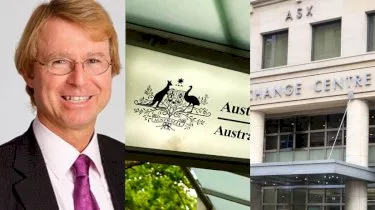Invest
More tax cuts on the way: Predictions for the federal budget
The federal government’s latest set of accounts makes one thing clear: bigger tax cuts are on the way in the next federal budget. AMP Capital chief economist Shane Oliver explores this, and what’s on for the week ahead, in his latest market update.
More tax cuts on the way: Predictions for the federal budget
The federal government’s latest set of accounts makes one thing clear: bigger tax cuts are on the way in the next federal budget. AMP Capital chief economist Shane Oliver explores this, and what’s on for the week ahead, in his latest market update.

Key developments in the last week
- Bigger tax cuts on the way in Australia in the April Budget.
The Federal Government’s Mid-Year Economic and Fiscal Outlook set aside around $3 billion a year in revenue “decisions taken but not yet announced” starting from next financial year and this presumably refers to tax cuts.
On top of this, budget data up to January shows this year’s budget tracking around $3 billion a year better than MYEFO projected and the rise in the iron ore price is likely to have added to this although it may be partly offset by a downgrade to economic growth, employment and wages assumptions for 2019-20. Overall though it looks like there is scope for around $6bn in extra fiscal stimulus in 2019-20 that would basically leave the budget projections into a surplus unchanged.

It would make sense for the Government to do this given the loss of growth momentum in the economy, but it would only be around 0.3% of GDP so a pretty small stimulus and the election would add a bit of uncertainty as to its timing.
That said this is on top of the $3bn in tax cuts already legislated from the May Budget last year. So, all up it would amount to a fiscal stimulus of around 0.5% of GDP, most of which would go to the household sector just at the time it needs it given falling house prices and a likely rise in unemployment. It won’t be enough to head off the need for RBA rate cuts, but it will help.
- Don’t panic! Panic! The Brexit fiasco.
While the rejection of a no deal Brexit was positive the margin was low, the vote was non-binding and in any case there is no majority support in Parliament for any one deal. So while the British pound hit a 9 month high in the last week, the Brexit comedy has a long way to go yet to being resolved. The best solution would be to have another referendum – which would likely see Bremain win. For investors on the other side of the world though it’s all just an entertaining sideshow having little impact on global markets (beyond the UK itself).
- Global share markets rose over the last week, helped by benign economic data.
Australian shares slipped though with consumer and financial shares down on worries about the economy. Bond yields were flat to up globally but fell in Australia with the 10-year bond yield falling back below 2 per cent for the first time since 2016 as weakening economic data adds to expectations for RBA rate cuts. While gold and copper prices slipped oil and iron ore prices rose. The Australian dollar also rose slightly as the US dollar slipped.
What’s on next week?
- In the US, expect the Fed (Wednesday) to leave interest rates on hold and indicate that the pause will continue for some time yet.
But even more significantly its likely to make some reference to moving to a framework that targets average inflation over time with the implication that it will allow a period of inflation above 2% to make up for all the years below) and there is a good chance that it will indicate a tapering in its process of balance sheet reduction (or quantitative tightening) in the second half ahead of ending it early next year. All of this is likely to be taken as dovish by investment markets.
- In Australia, expect ABS data to show a 2 per cent fall in house prices (Tuesday) for the December quarter.
This is consistent with private sector surveys and February labour force data (Thursday) to show a 5000 gain in jobs and unemployment rising to 5.1 per cent. The CBA business conditions composite PMI for March is likely to have remained weak. The minutes from the last RBA board meeting (Tuesday) will likely maintain a neutral bias on interest rates.

Investment insights
Global deal activity declines by 6% amid challenging market conditions, reports GlobalData
In a year marked by economic uncertainty and geopolitical tensions, global deal activity has experienced a notable decline, according to recent findings by GlobalData, a prominent data and analytics ...Read more

Investment insights
Furious five trends set to reshape the investment landscape in 2026
The investment landscape of 2026 is poised for transformation as five key trends, dubbed the "Furious Five" by CMC Markets, are set to dominate and disrupt markets. These trends encompass artificial ...Read more

Investment insights
Investors maintain cautious stance amid data uncertainty
Amidst the backdrop of a US government shutdown and lingering economic uncertainties, investors have adopted a neutral stance, as revealed by the latest State Street Institutional Investor IndicatorsRead more

Investment insights
State Street's 2026 global market outlook anticipates cautious growth with strategic investment shifts
State Street Investment Management, the world's fourth-largest asset manager, has released its much-anticipated 2026 Global Market Outlook (GMO) report titled "Forward with Focus." The report provides ...Read more

Investment insights
J.P. Morgan strategists highlight Australia as a key investment destination amidst global uncertainties
Amidst a backdrop of fluctuating energy prices, J.P. Morgan Private Bank strategists have identified Australia as a beacon of opportunity for global investors, particularly within its fixed income and ...Read more

Investment insights
HarbourVest Partners unveils new private equity benchmarks highlighting long-term outperformance
In a significant update for the private equity world, HarbourVest Partners, a leading global private markets investment firm, has released its quarterly private equity benchmarks, providing ...Read more

Investment insights
Mason Stevens strengthens UHNW offering through partnership with GloryHouse
In a strategic move set to bolster its position in the ultra-high-net-worth (UHNW) sector, Mason Stevens, a prominent name in Australia's wealth management landscape, has announced a partnership with ...Read more

Investment insights
Beyond the trophy: What the Women in Finance Awards 2025 signal for strategy, talent and ROI
Australia’s Women in Finance Awards have crowned their 2025 cohort, but the real story isn’t the stage—it’s the strategy. Recognition programs now function as market barometers, signalling which ...Read more

Investment insights
Global deal activity declines by 6% amid challenging market conditions, reports GlobalData
In a year marked by economic uncertainty and geopolitical tensions, global deal activity has experienced a notable decline, according to recent findings by GlobalData, a prominent data and analytics ...Read more

Investment insights
Furious five trends set to reshape the investment landscape in 2026
The investment landscape of 2026 is poised for transformation as five key trends, dubbed the "Furious Five" by CMC Markets, are set to dominate and disrupt markets. These trends encompass artificial ...Read more

Investment insights
Investors maintain cautious stance amid data uncertainty
Amidst the backdrop of a US government shutdown and lingering economic uncertainties, investors have adopted a neutral stance, as revealed by the latest State Street Institutional Investor IndicatorsRead more

Investment insights
State Street's 2026 global market outlook anticipates cautious growth with strategic investment shifts
State Street Investment Management, the world's fourth-largest asset manager, has released its much-anticipated 2026 Global Market Outlook (GMO) report titled "Forward with Focus." The report provides ...Read more

Investment insights
J.P. Morgan strategists highlight Australia as a key investment destination amidst global uncertainties
Amidst a backdrop of fluctuating energy prices, J.P. Morgan Private Bank strategists have identified Australia as a beacon of opportunity for global investors, particularly within its fixed income and ...Read more

Investment insights
HarbourVest Partners unveils new private equity benchmarks highlighting long-term outperformance
In a significant update for the private equity world, HarbourVest Partners, a leading global private markets investment firm, has released its quarterly private equity benchmarks, providing ...Read more

Investment insights
Mason Stevens strengthens UHNW offering through partnership with GloryHouse
In a strategic move set to bolster its position in the ultra-high-net-worth (UHNW) sector, Mason Stevens, a prominent name in Australia's wealth management landscape, has announced a partnership with ...Read more

Investment insights
Beyond the trophy: What the Women in Finance Awards 2025 signal for strategy, talent and ROI
Australia’s Women in Finance Awards have crowned their 2025 cohort, but the real story isn’t the stage—it’s the strategy. Recognition programs now function as market barometers, signalling which ...Read more








